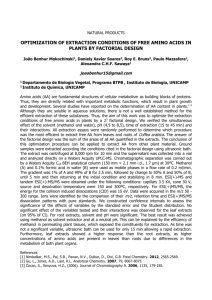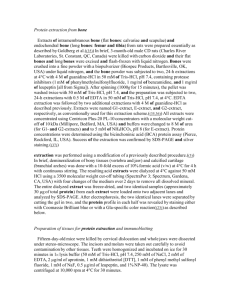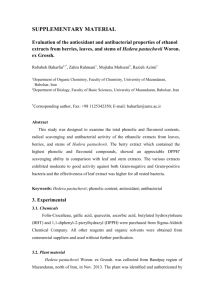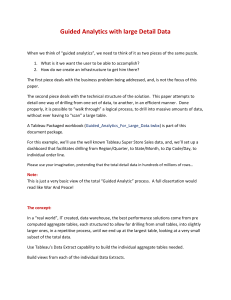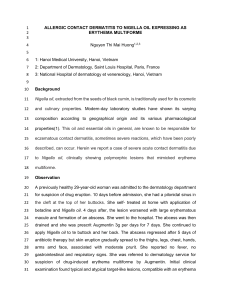British Journal of Pharmacology and Toxicology 1(2): 96-100, 2010 ISSN: 2044-2467
advertisement
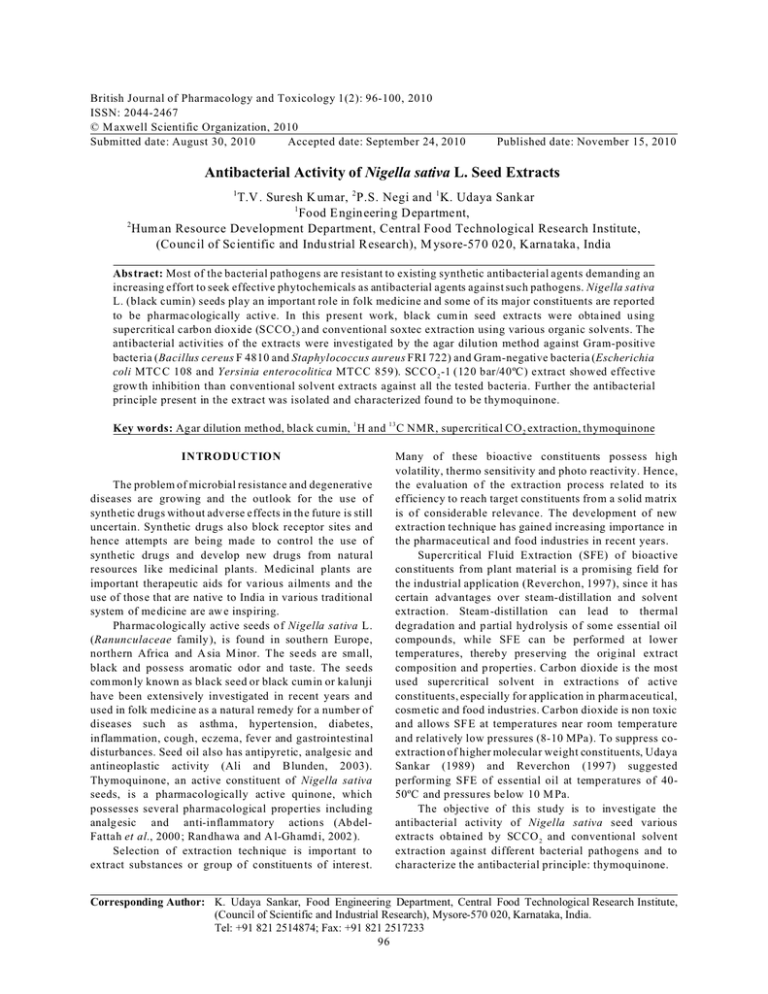
British Journal of Pharmacology and Toxicology 1(2): 96-100, 2010 ISSN: 2044-2467 © M axwell Scientific Organization, 2010 Submitted date: August 30, 2010 Accepted date: September 24, 2010 Published date: November 15, 2010 Antibacterial Activity of Nigella sativa L. Seed Extracts 1 T.V . Suresh K umar, 2 P.S. Negi and 1 K. Udaya Sankar 1 Food E ngin eering Department, 2 Hum an Resource Development Department, Central Food Technological Research Institute, (Council of Scientific and Indu strial Research), M ysore-57 0 020, Karnataka, India Abstract: Most of the bacterial pathogens are resistant to existing synthetic antibacterial agents demanding an increasing effort to seek effective phytochemicals as antibacterial agents against such pathogens. Nigella sativa L. (black cumin) seeds play an important role in folk medicine and some of its major constituents are reported to be pharmac ologically active. In this present work, black cum in seed extracts were obtained u sing supercritical carbon dioxide (SCCO 2 ) and conventional soxtec extraction using various organic solvents. The antibacterial activities of the extracts were investigated by the agar dilu tion method against Gram-positive bacteria (Bacillus cereus F 4810 and Staphylococcus aureus FRI 722) and Gram-negative bacteria (Escherichia coli MTC C 108 and Yersinia enterocolitica MTCC 859). SCCO 2 -1 (120 bar/40ºC) extract showed effective grow th inhibition than conventional solvent extracts against all the tested bacteria. Further the antibacterial principle present in the extract was isolated and characterized found to be thymoquinone. Key words: Agar dilution method, black cu min, 1 H and 1 3 C NMR, supercritical CO 2 extraction, thymoquinone INTRODUCTION The problem of microbial resistance and degenerative diseases are growing and the outlook for the use of synthetic drugs witho ut adv erse effects in the future is still uncertain. Synthetic drugs also block receptor sites and hence attempts are being made to control the use of synthetic drugs and develop new drugs from natural resources like medicinal plants. Medicinal plants are important therapeutic aids for va rious ailments and the use of those that are native to India in various traditional system of medicine are aw e inspiring. Pharmac ologically active seeds o f Nigella sativa L. (Ranunculaceae family), is found in southern Europe, northern Africa and A sia M inor. The seeds are small, black and possess aromatic odor and taste. The seeds com mon ly known as black seed or black cum in or kalunji have been extensively investigated in recent years and used in folk medicine as a natural remedy for a number of diseases such as asthma, hypertension, diabetes, inflammation, cough, eczema, fever and gastrointestinal disturbances. Seed oil also has antipyretic, analgesic and antineoplastic activity (Ali and B lunden, 20 03). Thymoquinone, an active constituent of Nigella sativa seeds, is a pharmacologically active quinone, which possesses several pharmacological properties including analg esic and anti-inflammatory actions (Ab delFattah et al., 2000 ; Ran dhawa and A l-Ghamd i, 2002 ). Selection of extraction tech nique is impo rtant to extract substances or group of constituen ts of interest. Many of these bioactive constituents possess high volatility, thermo sensitivity and photo reactivity. Hence, the evaluation of the extraction process re lated to its efficiency to reach target constituents from a solid matrix is of considerable relevance. The development of new extraction technique has gained increasing impo rtance in the pharmaceutical and food industries in recent years. Supercritical Fluid Extraction (SFE) of bioactive constituents from plant material is a promising field for the industrial application (Reverchon, 1997), since it has certain advantages over steam-distillation and solvent extraction. Steam -distillation can lead to thermal degradation and p artial hyd rolysis o f some esse ntial oil compoun ds, while SFE can be performed at lower temperatures, thereby preserving the original extract composition and p roperties. Carbon dioxide is the most used supercritical solvent in extractions of active constituents, especially for application in pharm aceu tical, cosm etic and food industries. Carbon dioxide is non toxic and allows SF E at tempe ratures near room temperature and relatively low pressures (8-10 MPa). To suppress coextraction of higher molecular weight constituents, Udaya Sankar (1989) and Reverchon (199 7) suggested performing SFE of essential oil at temperatures of 4050ºC and p ressures below 10 M Pa. The objective of this study is to investigate the antibacterial activity of Nigella sativa seed various extracts obtained by SCCO 2 and conventional solvent extraction against different bacterial pathogens and to characterize the antibacterial principle: thymoquinone. Corresponding Author: K. Udaya Sankar, Food Engineering Department, Central Food Technological Research Institute, (Council of Scientific and Industrial Research), Mysore-570 020, Karnataka, India. Tel: +91 821 2514874; Fax: +91 821 2517233 96 Br. J. Pharm. Toxicol., 1(2): 96-100, 2010 preculture was prepared by transferring 1 mL of culture to 9 mL of broth and was cultivated for 48 h. The cells were harvested by centrifuga tion (12 00 g, 5 min), washed and suspended in sterile saline under aseptic conditions. To flasks containing 20 mL of melted cool agar, different concentrations of extracts in propylene glycol were added. An equivalent amount of propylene glycol was used as controls. One hundred :l (about 10 3 cfu/mL) of each bacterium to be tested were inoculated into the flasks under aseptic conditions. The media were then poured into sterile petri dishes, in triplicate, and incubated at 37ºC for 20-24 h. After the incubation period, the colonies were enumerated and were used to find out the growth inhibition by using the following formula: MATERIALS AND METHODS This study was cond ucted during the period of A pril 2009 to June 2010 in our laboratories at Food Engineering De partm ent and H uman Reso urce Development Department of Central Food Technological Research Institute, (Council of Scientific and Industrial Research), M ysore . Nigella sativa seeds: The seeds were obtained from Supreem Pharmaceuticals Mysore Pvt. Ltd., India. Cleaned seeds were pulverized into a fine powder by an IKA -10 lab oratory mill. SCCO 2 extraction: SCCO 2 extraction was carried out in Nova Swiss high pressure extractor as described earlier (Udaya Sankar, 1989). Extractions w ere carried out on 1 kg of the pulve rized black cumin seeds at 40 a nd 50ºC at 120 and 280 bar pressures. CO 2 flow rate was 1.2 to 2.9 Kg/hr to obtain SCCO 2 -1 (120 bar/40ºC) and SCCO 2 -2 (280 bar/50ºC) extracts. Yield of extracts were monitored by weight of extract recovered and the n stored at 4ºC in dark until ana lysis. Inhibition (%) = (1 - T/C) × 100 where, T is cfu/m l of extract and C is cfu /mL of con trol. The lowest concentrations of the extracts capable of inhibiting the complete growth of the bacteria being tested were expre ssed as M inimum Inh ibitory Concentration (MIC) values. Soxtec extraction: 5 g of powdered seed w as used in a soxtec apparatus and boiled in respective solvents of hexane, ethyl acetate, m ethan ol, and methanol: Water (70:30 v/v) for 30 min and extracted for 3 h. After extraction, the solvents were removed by rotary vacuum evaporator (40ºC ) and d ried in a vacuum oven at 30ºC for 2 h. Purification: 5 mL of SCCO 2 -1 extract wa s subjected to purification in a glass column (40 × 450 mm) pack ed w ith activated silica gel (60-120 mesh) and eluted with hexane and ethyl acetate at 99:1 ratio. Fractions were collected and continuously monitored by Silica gel-G coated TLC plates with hexane: ethyl acetate (90:10 v/v) as developing solvent. The spots were located by exposing the plates to iodine vapo rs. Fractions having the similar pattern of the spots with similar Rf values were pooled and concen trated. It was used for spectral characterization studies. Preparation of extracts: The known quantities of solvent free extracts and SCCO 2 extracts were disso lved in propylene glycol for evaluation of antibacterial activity. Test bacteria: The microorganisms used were as follows, Bacillus cereus F 4810 (Public Health Laboratory, London, UK ), Staphylococcus aureus FRI 722 (Public Health Laboratory, The Netherland s), Escherichia co li MTCC 108 and Yersinia enterocolitica MTC C 859 (Microbial Type Culture Collection, Institute of Microbial Techn ology, Chandiga rh, India). Characterization of thymoquinone: Spectral characterization: Isolated thymoquinone besides measuring melting point was characterized spectroscopically by UV, IR, Mass and Two-Dimensional Heteronuclear Single Q uantum Coherence T ransfer (2D HSQCT) NM R spectra. Mass spectra were obtained using a Q-TOF Waters Ultima mass spectrometer. 2D HSQCT were recorded along with 1 H and 1 3 C NM R spectra on a Bruker Avance AQS-500 MH z NM R spectrometer (500.13 MH z for 1 H and 125 M Hz for 1 3 C) at 35ºC using 5 mg of the isolated thym oquinone in DMSO-d6 solvent. In the NMR data, only resolvable signals are shown. Some of the assignments are interchangeable. Certain quaternary carbons and proton signals could not be detected. Culture medium: Nutrient agar and brain heart infusion agar media and respective broths were used in the present studies. Antibacterial activity: The antibacterial activity was determined by ag ar dilution method (N egi et al., 1999) against the test bacteria. Yersinia enterocolitica was grown in brain heart infusion agar and the remaining test bacteria were grown in nutrient agar at 37ºC. Each bacterial strain was transferred from stored slants at 4-5ºC to 10 mL of broth and incubated overnight at 37ºC. A Thym oquinone: Solid, mp 45.5ºC; UV (alcohol, 8 max ): 278 nm (B6 B*, g 2 7 8 -2420 MG 1 ); IR (KB r) (stretching 97 Br. J. Pharm. Toxicol., 1(2): 96-100, 2010 Bacillus cereus Staphylococcus aureus Esc her ichia coli Yersinia enterocolitica Fig. 1: Inhibition of bacterial growth by black cumin seed extracts: 1. SCCO2-1 (120 bar/40 C); 2. SCCO2-2 (280 bar/50 C); 3. Ethyl acetate; 4. Methanol; 5. Hexane; 6. Methanol: Water (70:30 v/v) (SD values varied from 0-1.70% for Bacillus cereus, 0.392.03% for Staphylococcus aureus, 0-1.68% for Escherichia coli, and 0.10-1.42% for Yersinia enterocolitica) frequency): 2970 cmG 1 (CH), 1690 cmG 1 (C=O ); M S (m/z) 1 64 .1 2 [M ] + ; 2D HSQCT (DMSO-d 6 ) 1 H NMR * p p m (500.13): 6.59 (H-2), 6.72 (H-5), 2.12 (H-8, 5.3 Hz), 1.93 (H-9, 5.3 Hz), 1.94 (H-10, 5.3 Hz); 1 3 C NMR * p p m (125 MHz): 145.1 (C1), 133.5 (C2), 188 .3 (C3), 187 .3 (C4), 133.3 (C5), 156.4 (C6), 14.9 (C7), 31.0 (C 8), 26.7 (C9 ), 26.7 (C1 0). followed by SCCO 2 -2 and then by ethy l acetate extracts (Fig. 1). Bacillus cereus, Staphylococcus aureus and Escherichia coli show ed m aximum in hibition to both SCCO 2 and solvent extracts except methanol: water (70:30 v/v) extract. These observations were reflected in the MIC values of these extracts for different bacteria. MIC value of the SCCO 2 -1 extract for different bacteria was the lowest at 100-350 ppm followed by SCCO 2 -2 and ethyl acetate extracts. Yersinia enterocolitica was the most resistant bacterium to all the tested extracts as inferred from higher MIC values observed for it (Table 1). All the evaluated extracts were found to be active against Gram-positive than Gram-negative bacteria. The higher resistance of Gram-negative bacteria to external agen ts has been earlier documented, and it is attributed to the presence of lipopolysaccharides in their outer membranes, which mak e them inherently resistant to antibiotics, detergents and hydrophilic dyes (Nikaido and Vaara, 1985). Re sults of the present study are consistent with the literature data reported by Agarwal et al. (1979) and Alhaj et al. (2008). Thymoquinone was characterize d spectroscopica lly by UV, IR, Mass and 2D HSQCT NM R. 1 H and 1 3 C 2-D Quantification of thymoquinone: Quantification was carried out by HPLC on a C 18 reversed-phase : Bondapak analytical column (3 00 x 3.9 mm, 10 :m particle size), using an isocratic mobile phase of water: methanol: 2-propanol (50:45:5% v/v) at a flow rate of 1 ml/min. The elution was monitored by diode array detector at 254 nm. RESULTS AND DISCUSSION The present investigation reveals that the SCCO 2 extracts showed an effective antibacterial activity against the tested bacteria than the conventional solvent extracts. The SCCO 2 -1 (120 bar/40ºC) extract was more effective to inhibit the growth of tested bacteria which was 98 Br. J. Pharm. Toxicol., 1(2): 96-100, 2010 Tab le 1: M inim um inhib itory c onc entra tion (M IC) o f blac k cu min seed extra cts Extracts M IC a (ppm) ----------------------------------------------------------------------------------------------------------------------------------------------Bacillus cereus Staphylococcus aureus Esc her ichia coli Yersinia enterocolitica S C C O 2 - 1 ( 12 0 ba r/ 40 ºC ) 100 175 300 350 S C C O 2 - 2 ( 28 0 ba r/ 50 ºC ) 150 175 300 450 Ethyl acetate 150 200 300 500 Methanol 150 200 300 500 Hexane 150 225 300 550 Methanol: water (70:30 v/v) 200 250 350 550 a : MIC is defined as the lowest concentration of the extract capable of inhibiting the complete growth of the bacterium Fig. 2: ESI (-ve) MS finger print of purified SCCO2-1 (120 bar/40ºC) extract of black cumin seeds Tab le 2: Thymoquinone content and extract yield for diffe rent e xtrac ts of black cumin seed Ex tracts Thymoquinone Ex tract yie ld a c on te nt (% ) (% ) S C C O 2 - 1 ( 12 0 ba r/ 40 ºC ) 12.3±0.24 07.8±0.32 S C C O 2 - 2 ( 28 0 ba r/ 50 ºC ) 07.1±0.32 26.0±1.21 Eth yl ace tate 03.2±0.05 42.7±1.21 Methanol 02.7±0.16 37.3±1.30 Hexane 01.2±0.11 32.0±1.01 Methanol: water (70:30 v/v) 00.6±0.03 10.6±0.48 a : Extracts yield were expressed as % on dry weight basis of seeds CONCLUSION The present study shows that supercritical CO 2 extraction at 120 bar/40ºC is effective to obtain Nigella sativa extracts with antibacterial activity and better recovery of thymoquinone. It was also found that, the maximum recovery of thymoquinone without degradation is possible only in SCCO 2 extraction, which was higher than to conventional solvent extracts besides exhibiting a direct correlation to antibacterial activity. HSQCT spectra showed the presence of two carbonyl groups at 187.3 ppm and 188.3 ppm. Further, two arom atic protons were detected at 6.59 ppm and 6.72 ppm. A CH 3 group attached to an aromatic ring was detected at 14.9 ppm in the carbon spectrum. The presence of isopropyl group was detected by observing signals at 1.93 ppm and 1.94 ppm (doublet) and 2.12 ppm, all with the coupling constant of 5.3 Hz. A typical ESI (- ve) MS finger print of purified SCCO 2 -1 extract was depicted in Fig. 2 showed good correspondence for an m/z value of 164 . All these confirme d that it could be the antibacterial principle: thymoquinone. Using the calibration curve, the quantification of thymoquinone was achieved at 254 nm rangin g from 0.6 to 12.3% (Table 2). SCCO 2 -1 extract had higher thymoquinone content of 12.3% which is in agreement with similar values reported by Erkan et al. (2008). The extracts yield was calculated based on dry weight of the seed material and it ranged from 7.8 to 42.7% dw (Table 2). ACKNOWLEDGMENT The first author acknowledges the management of RVS College of Arts and Science, Co imbatore, Ta mil Nadu, India for sponsoring as a Teacher Research Fellow at CFT RI, M ysore and also the Director of CFT RI, My sore for providing the necessary facilities. REFERENCES Abdel-Fattah, A.F.M., K. Matsumoto and H. Watanabe, 2000. Antinoc iceptive effects of Nigella sativa oil and its major com ponent, thymoq uinone, in mice. Eur. J. Pharmacol., 400: 89-97. Agarwal, R., M .D. K harya and R. Shrivastava, 1979. Antimicrobial and anthelmintic activities of the essential oil of Nigella sativa Linn. Ind. J. Exp. Biol., 17: 1264-1265. 99 Br. J. Pharm. Toxicol., 1(2): 96-100, 2010 Alhaj, N.A ., M.N . Sham sudin, H.F. Zamri and R. Abdullah, 2008. Extraction of essential oil from Nige lla sativa using supercritical carbon dioxide: Study of antibacterial activity. A m. J. Pharm acol. Toxicol., 3: 225-228. Ali, B.H. and G. Blunden, 2003. Pharmacological and toxicological properties of Nigella sativa. Phytother. Res., 17: 299-305. Erkan, N., G. Ayranci and E. Ayranci, 2008. Antioxidant activities of rosemary (Rosmarinus officinalis L.) extract, black seed (Nigella sativa L.) essential oil, carno sic acid, rosmarinic acid and sesamol. Food Chem., 110: 76-82. Ne gi, P.S., G.K. Jayaprakasha, L.J.M. Rao and K.K. Sakariah, 1999. Antibacterial activity of turme ric oil - A byproduct from cu rcum in manufacture. J. Agric. Food Chem., 47: 4297-4300. Nikaido, H. and M . Vaara, 1985. Molecular basis of bacterial outer mem brane permeability. M icrobiol. Rev., 49: 1-32. Randhawa, M.A. an d M .S. Al-Ghamd i, 2002 . A review of the pharmacotherapeutic effects of Nigella sativa. Pak. J. Med. Res., 41: 77-83. Reverchon, E., 1997. Supercritical fluid extraction and fractionation of essential oils and related products. J. Supercrit. Fluids., 10: 1-37. Udaya Sankar, K., 1989. Studies on physico-chemical chara cteristic of essential oil of pepper (Piper nigrum L.) obtained by supercritical carbon dioxide. J. Sci. Food. Agric., 48: 105-112. 100
